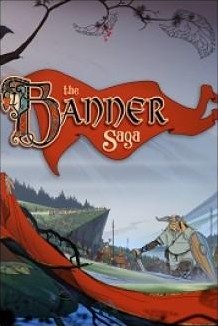The Banner Saga (PC) Review
By Javier Jimenez  20.01.2014
20.01.2014

Another day, another Kickstarter game finished, and more fuel for the argument of whether cutting out publisher middle men and funding developers directly is a smart idea or glorified electronic begging. Spotlight on The Banner Saga and Stoic Studio, which received over US$700,000 to fund its turn-based strategy, slash adventure, slash role-playing epic. Less than a year later and Stoic has delivered its product.
What has been delivered is some nice work, given the budget. The art assets, especially, shine. Gorgeous hand-drawn snowbound landscapes abound, with wonderfully stylised oval trees and jagged mountains. Enter a conversation and large, well drawn characters chat back and forth. Tassles on their clothing flutter. Flaps of their clothes flap back and forth.
In the background, some lovely period music - really good, orchestrated music - plays, completely fitting into the Viking-inspired setting without being painfully cliché. Even the voice actors - when there is voice acting (no, the game is not fully acted) - sound gravelly and beautifully authentically Scandinavian.
Kickstarter or not, The Banner Saga is one of the prettiest things that will be seen and heard this year.

This is a project on a budget, though, and not long into the game it shows. The same portraits are used again and again (and again), with no animation, no mouths moving, no arms moving, not even alternate static expressions of anger or surprise or laughter. The same tassles flutter the same way in Chapter 7 as they do in Chapter 1. The same "caravan riding along the landscape" concept, representing the group travelling, is recycled throughout the entire game.
One can easily imagine what could have been if given several million more dollars. The characters are so well drawn that they invite animation. The scenery is so pretty, it begs for more interaction. Thankfully, it is good enough to carry the game 'as is' at least.

Gameplay is a trickier matter, though. The Banner Saga is, at its core, a tile-based turn-based strategy game. Most of the player's time will be spent moving moving characters along a rectangular grid (sadly, the maps are almost invariably a large flat grid with no level geometry), one turn at a time, planning out attacks. That all works fine - it's a fun game, competently made, challenging, and interesting.
The system mechanics are engaging enough that the nine hours it will take to finish are not fruitless. The "health equals attack, and less health means less attack power" idea is very smart; so too is the armour breaking system whereby more armour means less damage and, thus, there is the question of whether one should break armour or attack health. Add in some between fight levelling up, some adventure game style dialogue choices (which can lead to gaining or losing characters), and even some Oregon Trail-style supply management, and here is a compelling game that's carried along well by its story, art, and music.

However, there are some glaring issues. Without spoilers, the final fight is a huge spike in difficulty that is out of line with the game's overall difficulty curve. It squanders some of the goodwill the game engenders up to that point and undoubtedly many players will be turning the difficulty down a notch to finish it. Still, that's a transient issue, easily addressed by proper enemy and encounter design in the next episode.
Less simple is that the game's only currency is "renown," gained by fighting and sometimes through dialogue. Food is purchased with renown. Characters are levelled with renown. Items are purchased with renown. Hence, if renown is not well balanced and if the player does not spend appropriately, then their units will starve, or their characters will be under-levelled, or they will not be able to purchase items (or all three, for that matter!).
"Okay, well, spend wisely," is the immediate thought. Unfortunately, the game does a poor job of teaching fiscal responsibility. In the first half, the player has the most powerful characters (giant "Varl"), renown is easy to gain, and food is handed to the party in numerous encounters. This teaches the player to level their characters up, and not to worry about buying food. Then, suddenly, in the last several chapters, the player is using weak humans that need to be levelled, food is taken rather than given, and towns that sell food now do so at exorbitant prices.
Even that is not the most critical sin, though. The most critical design sin is that it doesn't matter. Let all warriors, clansmen, and Varl starve to death. Go ahead and have terrible army morale. Just level up the key characters and waltz into the end game. There will be a small stat hit, but who cares: boss time!

Cubed3 Rating
Very Good - Bronze Award

The Banner Saga is a very good game with some obvious flaws. Some are due to budget, some are due to poor design. That doesn't stop the game from being fun, although it can make it occasionally frustrating. Still, it's worth playing and seeing and hearing.

![]() 7/10
7/10
![]() 0
(0 Votes)
0
(0 Votes)
 Out now
Out now  Out now
Out now  TBA
TBA  Out now
Out now Comments
Comments are currently disabled

 Sign In
Sign In Game Details
Game Details Subscribe to this topic
Subscribe to this topic Features
Features





 Top
Top

